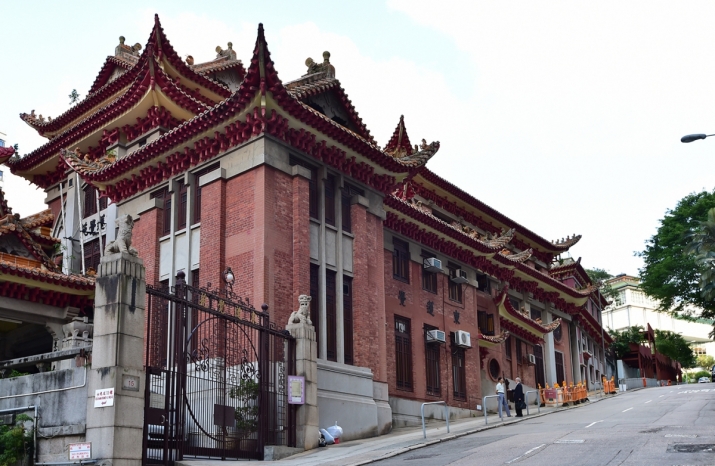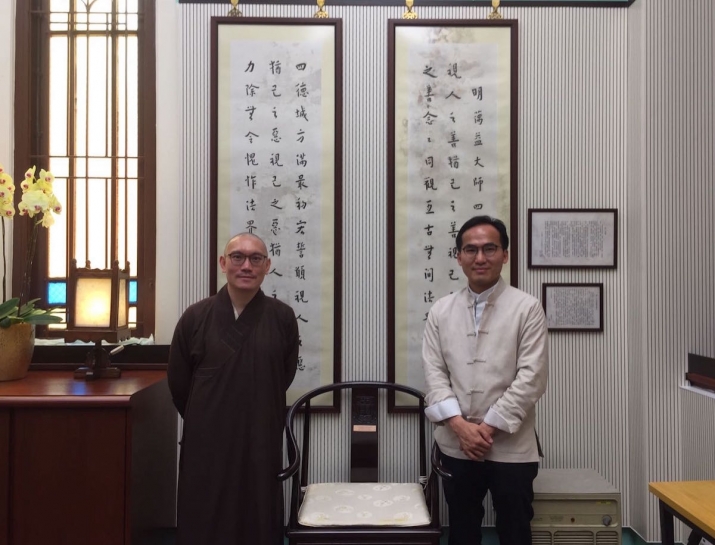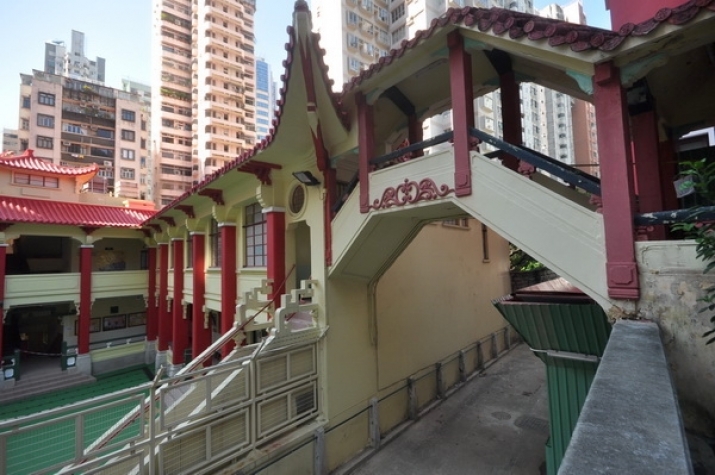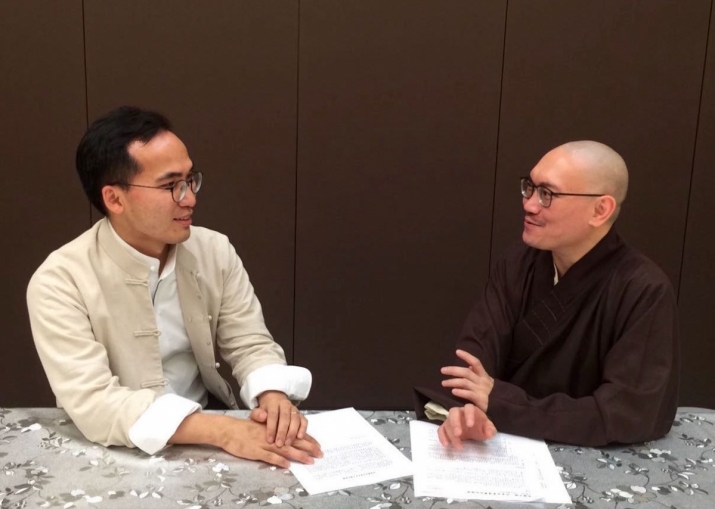FEATURES|THEMES|People and Personalities
Tung Lin Kok Yuen: A Living Monument to the History and Heritage of Buddhism in Hong Kong
 Photo by Bill Cox
Photo by Bill CoxThe Buddhist temple of Tung Lin Kok Yuen (TLKY), founded in 1935 by Lady Clara Ho Tung (1875–1938), is one of the most important Buddhist landmarks in Hong Kong. Since its founding, it has educated Buddhist monastics and served as a center of Hong Kong Island’s Buddhist community. On 8 June this year, The South China Morning Post newspaper reported that the Hong Kong Antiquities Advisory Board has recommended TLKY as one of three buildings to be declared monuments worthy of permanent protection, receiving the official recommendation that “every effort should be made to preserve [the building] if possible.”
Such buildings of outstanding merit are designated Grade I Historic Buildings. This recognition indicates that the physical future of the landmark is guaranteed and must be respected by all future governments. The additional endorsement as a “monument for permanent protection” provides further assurance that TLKY’s collaboration with the government to preserve its heritage will go smoothly.
This presents TLKY’s abbot, Ven. Tsang Chit and CEO Ernest Ng with the formidable but rewarding task of working with the government to develop a preservation plan that suits the structure’s needs. “That I can be part of this milestone is thanks to the Three Jewels [the Buddha, the Dharma, and the Sangha],” said Ven. Tsang Chit. “I feel so fortunate that TLKY has this endorsement, but it’s important to remember that TLKY is not just a monument. It is a living structure and organization.”
 TLKY's abbot, Ven. Tsang Chit, left, and CEO Ernest Ng, right
TLKY's abbot, Ven. Tsang Chit, left, and CEO Ernest Ng, rightErnest agreed, noting: “Each item in this temple has its own story to tell, not to mention the intangible heritage of this place—the transmissions of senior monastics to their students, the history of the people who came in and out of here, the tales of human interest that have been shared between the people here.” The history of this temple remains in the form of material heritage as well as archival records. The former consists of sculptures, plaques, calligraphy, and paintings, some of which are preserved at TLKY, Canada Society. While not all the written materials—correspondences, letters, documents, and the like—will be made available to the public, Ven. Tsang Chit and Ernest are both keen to explore how TLKY can reach a wider audience through books about its history and the story of Lady Clara.
I have been a regular visitor to TLKY since returning to Hong Kong in 2012, and the path of Shan Kwong Road has become a familiar one to me over the years: walking into the suburb of Happy Valley before strolling up that scenic hill. Just next to the temple, at the intersection of Shan Kwong Road and Tsui Man Street, is Po Kok Middle School, founded as a Buddhist school by Lady Clara in 1931 (but in a different location before being moved to its present site). Compared with the bland, utilitarian architecture of most Hong Kong schools, Po Kok stands out for its historical and aesthetic value. TLKY has many unique features, from the welcoming mezzanine to its beautiful stained glass windows. Personally, I like most the small, endearing bridge that connects the school premises to TLKY, which was originally a nunnery that sheltered and educated young women in Hong Kong.
There’s not just the “hardware” to be taken care of, but also the “software.” Ven. Tsang Chit and Ernest suggested that education has been TLKY’s core focus throughout Hong Kong’s history, and that it should aim to expand this focus, while exploring what it can do as a religious organization. While there are currently no specific strategies for expansion, my feeling is that the Dharma classes that have been taught by monastics and laypeople at the temple for years could provide a model for other events and programs. “Many Buddhist institutions have worked very closely with TLKY, and TLKY has always been committed to our focused objectives and projects,” said Ven. Tsang Chit.
 Image courtesy of City University of Hong Kong
Image courtesy of City University of Hong KongVen. Tsang Chit and Ernest both emphasized that TLKY, while now a landmark of the greatest importance in the government’s eyes, faces the ongoing question of what constitutes “preservation” for a living monument. It is one thing for a long-deserted but beautiful archaeological site to be conserved “as it currently stands,” a common if sometimes value-laden position for conservators. TLKY, on the other hand, remains in active use, despite its venerable age. People still access its extensive library and walk through its hallowed halls. Monastics still live there. Human contact with precious books, doors, and statues will occur. Complete conservation is unlikely to be possible or even desirable; a middle path must be found.
“I’m confident that due to how unique TLKY is, it will be a very significant conservation project for Hong Kong,” said Ven. Tsang Chit. “This goes beyond a private institution. Individuals and society are inseparable, and so we approach our work with the government in the same spirit. We must learn from each other.”
 Ernest Ng, left, and Ven. Tsang Chit, right
Ernest Ng, left, and Ven. Tsang Chit, rightVen. Tsang Chit observed as a final thought that the ultimate goal of Buddhism is the eradication of suffering. “Whether it’s conservation, education, or charitable works, the end of suffering is what we should be oriented toward. Ending suffering is what TLKY exists to do. We walk alongside the development of Buddhism in Hong Kong, and we look to the future as much as we learn from the past.”
See more
Hong Kong antiquities board declares three historic buildings worthy of permanent protection (The South China Morning Post)
Tung Lin Kok Yuen
Tung Lin Kok Yuen, Canada Society
Related features from Buddhistdoor Global
The Potential of Propagating Pure Land Buddhism in the West
Professor Lee Chack-fan, Heir to Master Taixu: Scientific and Cultural Sensitivity
The Spiritual Vision of Robert Hung Ngai Ho: “There are Many Ways to be a Good Buddhist”
Related news from Buddhistdoor Global
The Robert H. N. Ho Family Foundation Program in Buddhist Studies Awards 26 Scholars and Institutions
The Robert H. N. Ho Family Foundation Supports Five-year Lecture Series on Chinese Buddhism at SOAS














